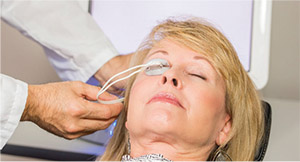 |
Problems that arise with the meibomian glands commonly involve physical blockage that prevents the meibum from coming out to aid the stability of the tear film. As a result, multiple devices have appeared in the marketplace designed to use heat and pressure to alleviate the blockages (as well as to remove residue along the lid margins).
Esen K. Akpek, MD, the Bendann Family Professor of Ophthalmology and Rheumatology at Johns Hopkins University School of Medicine, and director of the Ocular Surface Disease and Dry Eye Clinic at the Wilmer Eye Institute, says that unclogging the glands is sort of like removing dental plaque. “It needs to be done once in a while,” she says. “Just doing warm compresses at home is not adequate to address the problem.”
Here are brief profiles of several of the most popular devices for improving meibomian gland functionality.
• LipiFlow (Johnson & Johnson Vision; Santa Ana, California). The LipiFlow Thermal Pulsation System consists of a console and a single-use sterile device that uses sensor-regulated heat and peristaltic motion to evacuate obstructed meibum. One section of the device goes behind the eyelids, providing the warmth; an outer section gently massages the lids against the inner section. The device is designed to protect the cornea and globe from the heat and pressure.
Dr. Akpek uses LipiFlow on a regular basis. “LipiFlow is expensive, but it’s also effective, especially for mild to moderate posterior blepharitis,” she says. “It’s a cleanup modality for resetting the glands. Its advantages are that it treats both the upper and lower lids and it’s painless. However, it does not treat anterior blepharitis, and in my experience, it does not work well for severe disease.”
Kenneth A. Beckman, MD, FACS, director of corneal services at Comprehensive EyeCare of Central Ohio, and a clinical assistant professor of ophthalmology at Ohio State University, says he uses LipiFlow regularly. “I find that most of my patients have significant improvement,” he says. “I like to debride the lid margins gently with a spatula before applying the meibography at the exam to identify gland shortening, dilation or dropout, and I typically show the patients their images, so they can visualize and understand their problem. This definitely helps motivate patients to comply with treatment.” For more information, visit tearscience.com/lipiflow/.
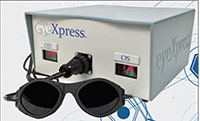 |
• eyeXpress (Holbar Medical Products; Tyler, Texas.) The eyeXpress is a therapeutic goggle system designed to provide uniform, regulated heat to the entire surface of the upper and lower lids. Dr. Beckman uses the eyeXpress as an adjunct to the LipiFlow. (Dr. Beckman is medical director for Holbar Medical Products.) “The eyeXpress is a heat mask that goes on the front of the eye and gets to a temperature of about 110 degrees,” he explains. “It doesn’t pulsate like LipiFlow, but it really heats up the surface nicely. I leave it on for about 15 minutes; then I personally express the lids. I usually get a lot of meibum out. It works well, and it’s less expensive than LipiFlow.
“A major advantage of the eyeXpress is that it’s not user dependent,” he continues. “You can put it on the eyes and leave. Some of the other devices need a technician and/or have to be held up to the face by the patient.
“I find that many patients need several sessions over several months,” he adds. “Often, if a patient is treated with LipiFlow, I include two eyeXpress sessions over the course of the year as part of the treatment package. It’s good for the patients and incurs minimal expense to me.” For more information, visit eyexpress.net.
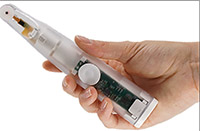 |
• NuLids. (NuSight Medical; Rancho Santa Fe, California) According to the manufacturer, NuLids is the first dry eye management system designed for home use. The NuLids handpiece is compact, cordless and portable. The once-a-day treatment—which takes about a minute to complete—involves using a disposable tip made of a soft silicone material to remove biofilm and scurf that may be occluding the meibomian glands’ openings. The manufacturer claims that a recent study found no evidence of any corneal scratching or abrasion even if the tip inadvertently came into contact with the cornea.
Helen K. Wu, MD, director of the Refractive Surgery Service at the New England Eye Center, and assistant professor of ophthalmology at Tufts University School of Medicine in Boston, has been trying the device with patients for several months. “Patients use the NuLids device daily to massage and clean the lids,” she explains. “It has a quad timer, signaling 15 seconds per lid for a total of one minute of care. The patient can place any cleanser on the disposable silicone tip, but a more viscous preparation works best. A gel preparation for dry eyes, such as GenTeal gel, also works well. The treatment is surprisingly gentle, with no pulling of lashes or ocular irritation. The lids of patients with anterior blepharitis immediately look better, and patients experience a ‘refreshed,’ ‘relaxed’ or ‘clean’ sensation.
“We’re currently selling the device to patients,” she says. “They get a 30day supply of silicone tips, which can be reordered through the company’s website. Initial feedback has been positive.” For more information visit nusightmedical.com.
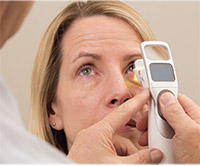 |
• iLux (Tearfilm Innovations; Carlsbad, California). The iLux is a handheld device that treats meibomian gland dysfunction with lightbased heat and compression, under direct visualization by the physician via a magnifying lens. The sterile, single-use, iLux Smart Tip has an inner pad that slips behind the eyelid being treated and an outer pad that’s pressed against the outer surface of the eyelid during heating and compression; the tip contains temperature sensors that maintain safe, therapeutic heat levels (between 104 and 108 F) during treatment. One-button control of heating and compression allows you to choose the location and duration of treatment. (iLux can treat both upper and lower eyelids.)
Sheri Rowen, MD, who practices at NVision Eye Centers in Newport Beach, California, and is a clinical assistant professor of ophthalmology at the University of Maryland, has used the iLux for several months. She says her experience has been very positive. “It’s quick and efficient,” she notes. “Treatments typically take less than 10 minutes, and because it’s portable I can use it in any room. I choose where to treat each lid based on meibography images and the expressibility of the glands I observe at the slit lamp. “Heating time and compression are under my control, and the magnifying lens lets me view the blocked meibomian gland orifices and expressed meibum during treatment,” she continues. “That’s helpful because I can see the result of the treatment and tell the patient what I’m seeing. I like to use it in combination with the BlephEx device, which removes the bacterial load and biofilm, and the results have been quite positive. The treatment can be repeated in a few months if needed.”
Dr. Rowen adds that it’s painless.
“Patients enjoy it,” she says. “They describe a gentle warming sensation. The fact that the device and Smart Tips are reasonably priced makes the procedure affordable for patients, and they really appreciate a comfortable method of addressing their dry-eye problem. Patient acceptance has been very high.” For more information visit tearfilm.com/ilux-device/.
• IPL (Intense Pulsed Light). Intense pulsed light, or IPL, was originally developed for use in dermatology. Brief, powerful bursts of light at specific wavelengths (in this case, between 500 and 800 nm) cause changes in blood vessels near the surface of the skin, raise skin temperature and eliminate problematic flora on the skin and eyes, all of which may have a beneficial effect on meibomian gland dysfunction. (Many devices capable of producing this effect are on the market, but a popular one is the Quadra Q4 produced by DermaMed Solutions [Lenni, Pennsylvania].)
Dr. Akpek says she uses IPL on a regular basis. “I find that it’s very effective in severe dry-eye cases with significant disease,” she says. “It’s effective for both anterior and posterior blepharitis, particularly for treating Demodex mites, which are more common than most physicians think. However, IPL can be painful, it mostly treats the lower lid, and it cannot be used on darkly pigmented individuals.” For more information, visit dermamedsolutions.com/spa_equipment/ intense_pulsed_light/overview/.
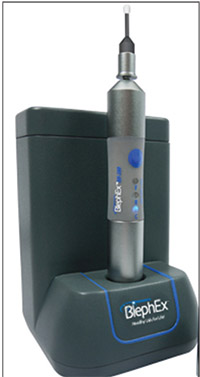 |
• BlephEx (RySurg; Palm Beach, Florida) BlephEx is a painless in-office procedure performed by the physician in which a handpiece spins a singleuse, disposable, medical-grade microsponge along the edge of the eyelids and lashes, removing scurf and debris and exfoliating the eyelids. The procedure typically lasts six to eight minutes and is well tolerated. It’s typically repeated at fourto six-month intervals.
Dr. Akpek notes that like IPL, BlephEx works best in more severe dry-eye cases. “BlephEx is a handheld device that removes inflammatory biofilm,” she explains. “It’s good for anterior or posterior blepharitis. I almost always use this to exfoliate the lid margin skin and better expose the gland orifices before performing other procedures.” For more information, visit rysurg.com.
 |
• Thermoflo (MIBO Medical Group, Dallas) The Thermoflo consists of a control unit and handpiece that delivers heat at 108 degrees F through a silver eye pad used with ultrasound gel applied to the tarsal conjunctiva. The control unit features an LCD touch-panel display that lets you adjust treatment time and settings.
Bruce Koffler, MD, medical director of Koffler Vision Group in Lexington, Kentucky, uses the Thermoflo. He says he places the heat paddle on each eye for 15 minutes. “After that we leave a heat mask on the patient’s eyes until I’m able to come to the room,” he says. “When I get in the room, I have a double-pronged paddle made of very smooth metal that goes in front and in back of the lid. I go right across the lid and apply gentle pressure to express some of the oils.
“I initially need to perform the procedure every six to eight weeks, while the patient continues doing daily lid hygiene with scrubbing and heat,” he notes. “Eventually I’ll do it three or four times a year and then move to semiannual treatments.
“The Thermoflo was affordable for our practice, and that’s allowed me to keep the out-of-pocket cost affordable for the patient,” he says. “We feel it’s a great compromise that gives us treatment availability at a reasonable price.” He adds that the Thermoflo unit has no disposable parts. “That’s a good thing,” he says. “We’re very happy with the Thermoflo.” For more information, visit mibomedicalgroup.com/mibothermoflo.html.
A Key Part of Treatment?
“Using these devices to reset the glands, I believe, is very important for the meibomian glands’ longevity,” notes Dr. Akpek. “They should be used on the glands before they atrophy. There’s no downside other than their expense. I’d use them on everybody if we could do them for free.
“In any case,” she adds, “if you’re dealing with very severe meibum-deficient dry eye, a combination of these treatments will probably work best for your patient.” REVIEW



